Kitchen Project #66: Chocolate-chocolate babka
Let's get into the swirly dream world ft. babka queen Talia Berk
Hello,
Welcome to today’s edition of Kitchen Projects. I’ve got a classic & very satisfying to make bake for you today… BABKA!
We’ll also be guided by the babka queen that is Talia Berk of the Painted Dog Bakehouse - and over on KP+, she’s sharing her recipe for caramelised white chocolate, hazelnut & malt spread. Heaven.
What’s KP+? Well, Kitchen Projects+ aka KP+, is the level-up version of this newsletter. It only costs £5 per month (that’s £1.25 a week!) and your support makes this newsletter possible. By becoming a member of KP+, you directly support the writing and research that goes into the weekly newsletter as well as get access to lots of extra content, recipes and giveaways, including access to the entire archive. I really hope to see you there:
Love,
Nicola
In search of Babka
The first time I made babka it was 2AM. I was working night shifts at Little Bread Pedlar at the time and even though I’d worked there for almost six months, I still got confused about the ‘midnight’ shift start time. I mean, does it belong to today or tomorrow?! Anyway, one Wednesday evening, my alarm went off at 8:30PM and, after exchanging a few texts with my boss, I realised I had got it wrong and I wasn’t due in for over 24 hours. Having just woken up from a lovely sleep and not at all tired, I figured it was best not to throw off my sleep schedule - I had a whole night ahead of me. Should I hit the clubs and party all night? Nah. I’ll stay at home and make babka (I used David Lebovitz’s recipe!). It was a nutella babka and, though not very pretty, I was enamoured.
Ever since then, I’ve always had a soft spot for the rich, twisty bread. Babka, simply known as ‘Yeast Cake’ at Daniel’s bakery in Fortune Green, is an iconic sweet bake typical of Ashkenazi Jewish traditions. It has been reimagined and recreated over the years (my milk bread spring onion babka is the opposite of traditional and is more of a franken-babka) but its basic form stays the same - enriched dough swirled with fillings and baked in a loaf pan. I really enjoyed reading this article about finding the soul of the ever-changing babka.
In conversation with a babka pro
I’m happy to admit that I’m much more of a babka fan than a bakba pro, so for this week’s KP I needed a babka guide. And who better than Talia Berk, proprietor and founder of the Painted Dog Bakehouse?
Established at the end of 2019, Painted Dog Bakehouse is THE go-to babka with an ever rotating menu of flavours. Whether it’s a babkastollen (genius) at Christmas, or an early Spring Rhubarb and Custard, or a classic chocolate, the painted dog signature is a babka with countless, intricate layers. They are visually stunning, and taste even better than they look. The Painted Dog babka is available to buy direct from the website or you can pick one up IRL in various places around London including Selfridges, Melrose & Morgan and Franks Canteen to name just a few.
I was lucky enough to work with Talia when she was still in the process of developing her business and am very proud to have been an early taste tester, so I’m thrilled to get the 4-1-1 from her today. Let’s get into it.
So Talia, tell me… what is your babka origin story?
I grew up with babka being baked by my grandmother in South Africa, then when my family moved to the UK my mother baked it to her grandmothers recipe. It was always baked to break the Yom Kippur fast. A few years ago (I guess back in 2017/2018) I started to miss babka - sadly my mums recipe book went missing along with my great grandmothers recipe. So I slowly started to look into recipes available online/in books, and then it kinda snowballed.
How did you go about developing your recipe?
I worked from the various recipes I had found - they weren’t quite what I was looking for, so I started tweaking them. I also researched babka from bakeries in NYC (as I knew babka was a big deal there) I should add that the babka in NY and recipes I researched were nothing like the babka I grew up with - but going deep into research I decided to bring together the things I’d learnt working in kitchens (flavour forward - lots of filling) and make it modern so it resembled the babka that was starting to pop up all over the place, that classic swirly top - but I also wanted to make mine a little unique. Babka from Oneg Bakery in Williamsburg was a big inspiration. I still need to plan a trip to NYC for the ultimate babka pilgrimage.
How many iterations of the painted dog babka has there been?
I’ve lost count to be honest - even when I thought I’d landed on my recipe I still tweaked it, even a year into Painted Dog Bakehouse.
Which part of the painted dog babka took the longest to perfect?
The dough I suppose, some fillings/flavours come together fast because I have good sense now of the formula but occasionally something will drive me nuts and not work.
What was the biggest struggle you had to overcome?
Working out shelf-life and packaging. I started PDB with the intention of it being an online/mail order business so top priority was that it still tasted good after being handled by the postal service… there are bound to be delays and they are not gentle with parcels!
What is your favourite part of the babka making process?
Finding little love hearts that randomly occur when I’m spreading the filling.
Where do you look for inspiration for your babka fillings?
Everywhere (you may roll your eyes) I like to use seasonal ingredients or be inspired by an upcoming holiday/festival but sometimes inspiration can come from a meal out or discovering a new ingredient and thinking of ways I can incorporate that into a babka filling.
Do you have a babka unicorn aka a flavour that you really want to nail?
I’m not sure I have a unicorn but I do often wish I could offer savoury flavours. It’s just not possible to keep savoury babka shelf stable (without using additives) That stock syrup is so important! Generally I’ll find a way to work with a flavour. If it doesn’t translate well and I can’t find a solution I’ll retire the idea.
Okay, let’s get technical… starting with dough. What is your process for making your dough?
I have developed a time system which works best. Making dough in a 20 litre mixer is VERY DIFFERENT to making dough for 1-2 babkas in a domestic stand mixer. The bulk of the ingredients go in first, then I go through strages of letting the dough mix/rest/enrich
What kind of dough hydration do you think works best for babka? (Side note: I’ve always used a demi brioche with 25% butter and about 73% hydration, but I’m thinking that’s way too high now and I’m experimenting with a much lower %)
My hydration is a little lower 55-56% but my butter 39% is higher. So perhaps the water content from that evens it out?
How do you roll your dough thin whilst keeping the integrity?
It’s important you have really good stretch in the dough & roll it out gently.
And how thin should we aim to go?!?! (Side note: I find that if I roll my dough really thin, it falls apart when I try to shape it/the filling is too heavy)
I personally go as thin as possible- but that’s because I aim for maximum layers in my babka. Perhaps you’re using too much filling? Generally My fillings are 50-65% the weight of dough I’m using. If you’re adding lots of chunky bits too they can poke holes in - as long as I can still roll it up and twist - you’re good to go.
What are your top tips for creating a fudgy filling that keeps defined layers?(Side note: I find that if my dough is too high in chocolate, it sets before I shape it! But then getting the temp right for spreading is hard, too! I think I have temp struggles lol)
The temperature of your dough might need to be a factor here. Chocolate filling is definitely the most fickle. You have to work fast. I like my chocolate filling to be warmed until spreadable so not too hot. Then once it’s on there spread fast, sprinkle any additions on and roll. I think I’ve worked out a system for this but then I am making multiple babkas at a time.
The level of definition you achieve with your babkas is amazing! Any top tips for keeping it so neat?
Roll that log nice and tight! And the thinner the dough the more layers when you slice it which helps to make that top look all the more impressive.
How do you balance the dough and fillings? Do you have a preferred ratio?
50-65% of the dough weight
When it comes to proofing, how far do you need to push the babkas? Is it like with croissants, when you have to push it as far as possible, or do babka’s not need quite as much proofing?
I use a proofing cupboard- so that makes my timings and bakes more consistent. But you definitely won’t get the same impressive puffiness as you would with a well proofed croissant. My theory is that those fillings are weighing things down. Look for that classic finger impression staying in the dough.
How do you feel about syrup? Is it essential? Do you switch up your syrups depending on flavours?
The syrup for me is essential. It makes sure my babka stays moist and also helps with shelf stability. I like that you can have fun with the syrup. Flavour it, infuse it, add some booze! On the most part I use the same syrup for all my babka - unless a particular flavour calls for something special. This is mostly because of lack of space and being more efficient. My Black Forest babka has a cherry & kirsch syrup which is pretty special! I suppose you don’t have to use any if you’re gonna eat the loaf right away - but it can never hurt. I would love to offer savoury loaves but douching them in sugar syrup wouldn’t work.
Thank you so much Talia! For more information on Painted Dog Bakehouse, or to order yourself one (pro move!) visit https://painteddogbakehouse.com/ and follow the Painted Dog Bakehouse Instagram for all the latest menu updates.
Over on KP+, Talia is has shared an incredible recipe for caramelised white chocolate, hazelnut & malt babka filling/spread. Yes, it really is as good as it sounds and can be eaten with a spoon (highly recommend doing this). Click here for the recipe.
Finding the babka
Armed with intel from Talia, I threw myself head first into babka testing. I’ve made babka a few times over the years and never quite nailed it. For starters, my past babka never had quite enough layers and I always felt the filling wasn’t substantial enough. For this recipe, I really wanted to figure out a way to maximise the impact of the filling both visually and flavour wise.
The dough
When it comes to the dough for babka, it’s got to be brioche doesn’t it? I’ve said it before and I’ll say it again… brioche IS cake. Over time I think we’ve become a little fussy about what we think of as cake, especially if it’s raised with anything other than baking powder or egg foams, but yeast is totally a player in the cake game. Given that babka is also known as ‘krantz cake’ or, even more simply as ‘yeast cake’, today’s babka - when you eat it - is far more like cake than bread, in the best way.
I know we’ve discussed brioche before, but I wanted to run down the basics with you again. Brioche comes from the word ‘broyer’ which means ‘to pound’ -–from that I basically take that people have hated mixing brioche by hand since the 17th century. I still haven’t tried doing it myself. I’ve looked through all of my pastry books and understand this: for brioche to be brioche, it needs a LOT of fat. It usually has higher % of eggs than other enriched doughs.
When you’re mixing brioche, the butter isn’t added until the end, after at least medium gluten development has been reached. This is because fat inhibits gluten. Gluten can’t form without water and as we know, water and fat do not mix. So, if you add fat, you are creating a fatty coat to the flour that water cannot penetrate, and so gluten can’t form as easily. Whilst the sugar, salt and yeast quantities remain the same, brioche recipes are diverse in their butter % and hydration, which we’ll get into shortly.
Until this week, I’d never formulated a recipe especially for babka. In babka’s past, I have always leant on my trusty demi brioche formulation for a rich but not too rich base. Demi brioche has all the classic components of a brioche (enriched with fat, eggs and milk) but has less butter than a standard brioche (hence ‘demi’). Standard brioche is usually within the region of 40%-60%+ butter. My classic, which you’ve seen before, has 45% butter. For my go-to demi brioche, I cut the butter to 30%, but everything else remains the same. Here’s the breakdown below:
By cutting the butter, we get a slightly less rich and ‘dry’ brioche. The unique close texture of brioche is all thanks to the solid fat emulsified throughout the dough. As it melts in the oven, it creates little air pockets around the gluten structure, giving it the rich, fine crumb. As it cools down, the remaining fat solidifies giving the bread its stretchy and springy quality with a melt in your mouth quality to it.
To start off this week’s tests, I used the classic demi brioche and found the dough really hard to work with. Although it was tasty enough, it was extremely sticky when I rolled it out and found it wasn’t able to hold the aggressive amount of fillings I wanted. If I wanted to have the multilayered babka of dreams, I’d have to figure something else out. It was then I realised - HYDRATION! I foolishly associated high hydration = stretchy and when this actually isn’t true at all. Take the cannoli, or strudel dough for example. Both of these doughs are low in hydration but are incredibly elastic.
In the two brioche formulations above, the relative hydration is pretty high - around 75% all-in. This works well for buns and loaves and creates a lighter, arier texture since the relative quantity of fat is reduced, but this isn’t great for babka shaping. As well as this, I know from my tarte tropezienne tests that eggs radically increase the rise of brioche dough - although this is favourable for certain products, the babka doesn’t need significant lift.
So, it was back to the spreadsheet drawing board to develop a dough that would be ideal for babka and babka alone - this meant a rich dough that could maintain integrity when rolled out very thin. I needed to keep the dough enriched, but knew I could drop the eggs slightly to help with definition. It’s also worth noting that eggs are usually responsible for adding flavour into brioche, but since the filling is the star of the show, I figured they wouldn’t be missed too much. As well as this, I found the dough slightly sweet especially with all the fillings and syrup so I knew I could safely drop the sugar without any issue. With a little bit of tweaking, I landed on the formula below. I’ve included the demi brioche and classic brioches so you can clearly see where the changes have been made:
As you can see, the milk has increased slightly but the eggs have radically decreased, resulting in a relative hydration (excluding butter) of 60%. Since I am trying to solve for a dough that is easy to work with, I exclude butter from my hydration calculations. When the dough is cold, the butter firms up, so having a high proportion of butter in the dough is actually really useful - the interplay of elasticity from gluten development and firmness provided by the chilled fat makes this formulation a dream to work with. You can stretch it incredibly thin without any issues with tearing and quite solid after a rest in the fridge thanks to the generous butter quantity.
Now the dough is sorted, let’s talk filling.
Figuring out the filling
I’m always amazed at how much babka you get for your buck. A small quantity of dough seems to dramatically multiply as you add fillings, roll it up and start shaping. But have you ever made a babka and filling seems to… disappear during the bake? Me too!
In the past I’ve found myself disappointed with the flavour and intensity of the filling after baking. This is presumably due to the evaporation of liquid/butter via steam during the bake. As a result of this disappointment, I wanted to formulate a filling that would stay put. From searching online, the main players seem to be double cream, chocolate, cocoa powder, sugar and butter.
I put a variety of formulas to the test with varying % of solids, from the chocolate itself and cocoa powder and sugar, as well as seeing how a ganache would fare. This provided me with a basis to compare fat, sugar and hydration. As well as this, I wanted a filling that would behave itself during the shaping process. Too much chocolate, it would set solid and interfere with the rolling, but too little chocolate… where’s the fun in that? Although many recipes online tend to favour icing sugar as a sweetener/bulker, I’m really not a fan and decided to use dark brown sugar as my standard sugar ‘seasoning’. Here’s what went head to head:
As you can see from the above, the range of hydration spans 4% to a loose 50%, whilst the chocolate content went from a paltry 23% overall to a much more generous 62%. Flavour-wise, fillings 3 and 4 had the lightest flavour. The ganache (Filling 3) more or less disappeared during the bake despite being proportionally high in chocolate, likely due to its very high hydration. Test 2 was fudgy but a little light in flavour. Tests 1 and 5, with the relatively low hydration, had the most dense and rich fillings but test 1 was quite hard to work with and 5 was a little sweet. To get my ‘perfect’ filling, I married together Test 1 and 5 to create a filling that was low on the hydration side, still at least 50% chocolate and with a lower sugar. The result is a fudgy filling that stays put whilst baking and feels substantial when you bite into it:
Another tactic I’ve seen employed for fudginess is the use of a crumb. In my first ever babka ℅ David Leibowitz, I sprinkled cookie crumbs all over the babka before rolling it up. As a result, I got an increased level of fudginess as the crumbs absorbed the filling during the bake. I DEFINITELY wanted to repeat this again (and FYI, I realised you don’t have to pre-bake the crumbs before they go into your babka because they bake whilst the babka bakes!) And, of course, there is always the option to add chocolate chips. This was also my opportunity to test out ratios between crumb, chocolate chips and filling:
In the least surprising result of the century - the babka with both chocolate chips and crumbs won by a country mile. It stayed the fudgiest and it was easily the most fun to eat. That being said, the babka is still fab without, but if you’re going all in… like, why not go all in?
The shaping and proofing
The biggest discovery this week was just how thin you need to take the babka to get a significant swirl - way thinner than you think. For the 275g dough, I found a 45-50cm x 25-30cm rectangle worked well. I pushed this to 65cm x 30cm, but found the dough a bit too thin and fragile.
And to get the most swirls? The direction you roll it up matters! The breakthrough moment for me was watching the BTS video of the Russ and Daughters production kitchen and seeing that they sheet their babka into very long sheets, rolling up horizontally to maximise the amount of swirls and layers.
Finally, you’ve got two options when it comes to shaping. The first is the type I’m most used to seeing now - once rolled up, the babka is split down the middle, revealing the layers, and the dough is twisted and laid in a pan face up. The other is a shaping method favoured by Melissa Funkweller, author of ‘A Good Bake’ (a truly brilliant baking book!) - the dough is not slashed down the centre but still braided - the result is an incredibly groovy internal swirl, though it doesn’t have such an impressive birds eye view (perhaps why Funkweller covers in ganache). I tried both out and i’ll show you how to do both, since it really is a matter of preference.
I became quite enamoured with the mini babkas - if you want to do mini babkas, I found 60g of dough perfect for these types of cases.
For the proofing, I think you need to push it quite far - I would say at least 1.5 hours, but 2 hours better at room temp. For the baking, there is a fine line between underbaked (raw) and overbaked (dry!) so taking the internal temp is the best way forward - we’re looking for 88c!
Alright, let’s make it.
Chocolate chocolate babka
Due to length restrictions, the instructional GIFs are available in the web version of this newsletter.
Babka dough
Makes enough for 2 x babkas baked in 6 x 3 inch tins
285g strong bread flour
25g caster sugar
7g salt
5g dry active yeast
115g whole milk
55g whole egg
80g butter, soft
Chocolate Filling
140g dark chocolate
75g butter
60g dark brown sugar
30g cocoa powder
1-2g flaky salt
Chocolate crumb
25g butter, melted
25g light brown sugar
45g plain flour
5g cocoa powder
Pinch flaky salt
Cinnamon syrup
75g sugar
75g water
1 cinnamon stick
Plus 100g hand chopped chocolate and egg wash.
Method - babka dough
First, check the instructions on the back of your yeast packet and bloom if required!
Mix the dries on a low speed with the dough hook until everything is distributed
Pour in the wet ingredients and mix on a medium speed for 5-6 minutes until a homogenous dough forms. Due to the low hydration, it will be harder to spot significant gluten development
Start adding the butter piece by piece. Do this slowly - the dough takes longer to come together than a higher hydration brioche than you might be used to seeing. Scrape down the sides of the bowl regularly and just keep mixing - it needs to pull clean away from the sides of the bowl
Once it is completely developed (I think it takes at least 10-15 minutes), take the dough out of the bowl and finish with a few slap and folds to really strengthen that gluten!
Leave to proof for around an hour until doubled in size (make the fillings during this time!)
Press into a tray and chill either overnight in the fridge or in the freezer until cold enough to handle
Method - chocolate filling
Over a bain marie, melt together the butter and chocolate then stir through the brown sugar and cocoa powder
Leave to cool - you want to spread it whilst its the texture of nutella. Simply pop over the bain-marie and heat a little if it sets up too much
Method - chocolate crumb
Mix the dries together then pour over the melted butter (or, if easier, pour dries into melted butter!) then mix until fine crumbs form. Set aside
Method - cinnamon syrup
Heat sugar, water and cinnamon together and boil for 2-3 minutes
Set aside to cool
Shaping
Divide dough in half - you want about 275g for per babka
Instead of flour lightly oil your work surface (I used cake spray) and begin rolling out your dough. You want to go quite thin - we are looking for 50cm x 30cm ish
Now spread your filling on evenly, going all the way to the edges, then sprinkle over the crumb and chopped chocolate
Roll up the babka, short side first, trying to keep it really neat and tidy. I find a dough scraper really helps!
Once rolled up, shape as desired using one of the techniques below:
Method 1: Press down on the roll to flatten so its easier to judge where the middle is. Cut down the centre (try to keep it even!) to reveal the beautiful cross section and then braid. Pop into a tin.
Method 2: Cut log in half and then braid (no cutting!). Place into a tin
Proof babkas for 1.5h-2h until very puffy. It won’t double - the dough is stretched quite thin - but it will look hefty. I tend to just pop mine into the oven (switched off) with a pan of boiling water next to it which I replace every 30 mins or so
Pre-heat oven to 175c fan
Egg wash lightly - if you are using the second shaping method, there is more dough to egg wash!
Bake for 40 minutes. I like to check it’s baked through by using a thermometer to take the internal temp - you want it to be over 88c please!
Brush with syrup - you need to use more if you’ve shaped it the cut face up way. Leave to cool in tins




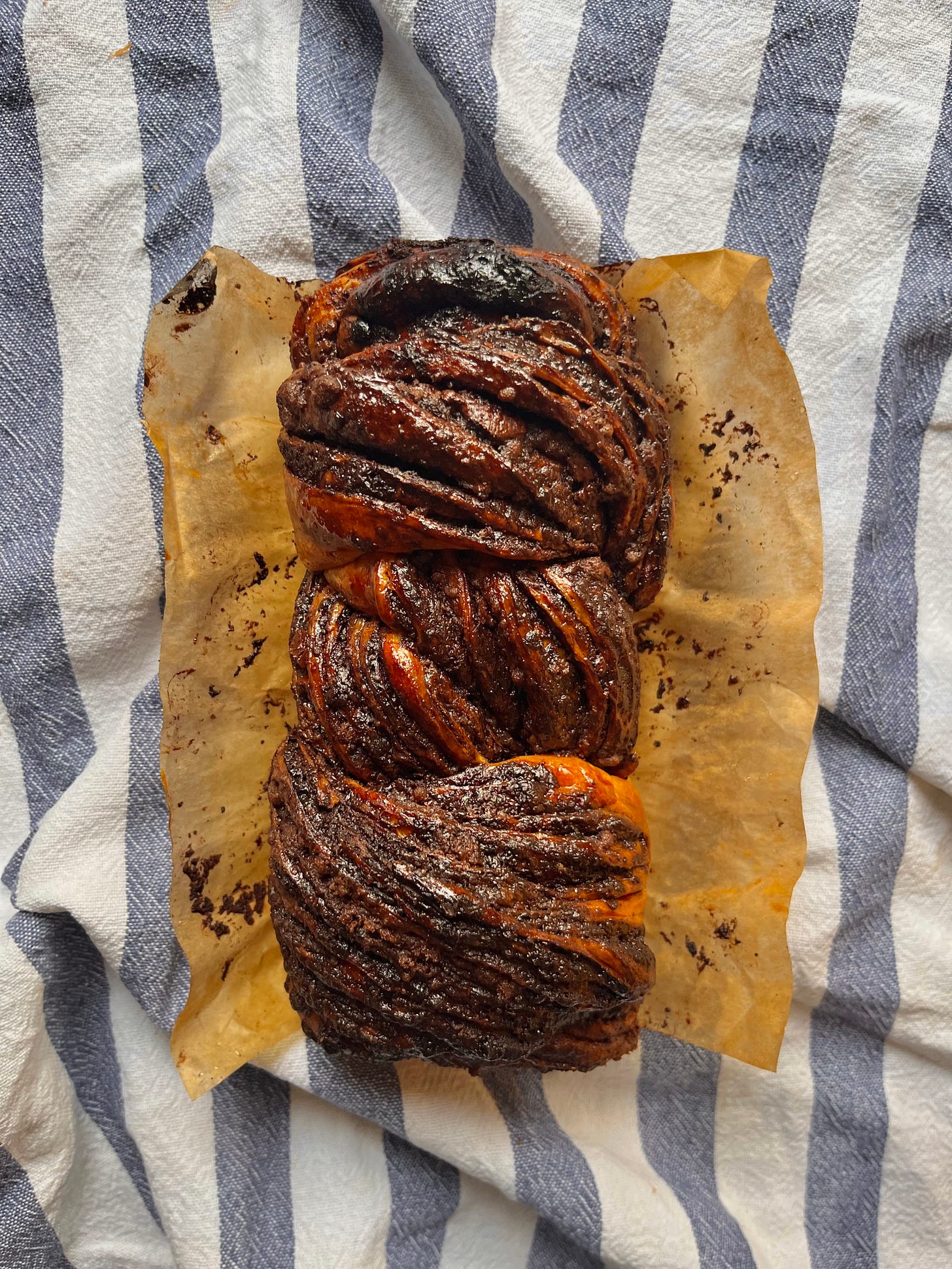
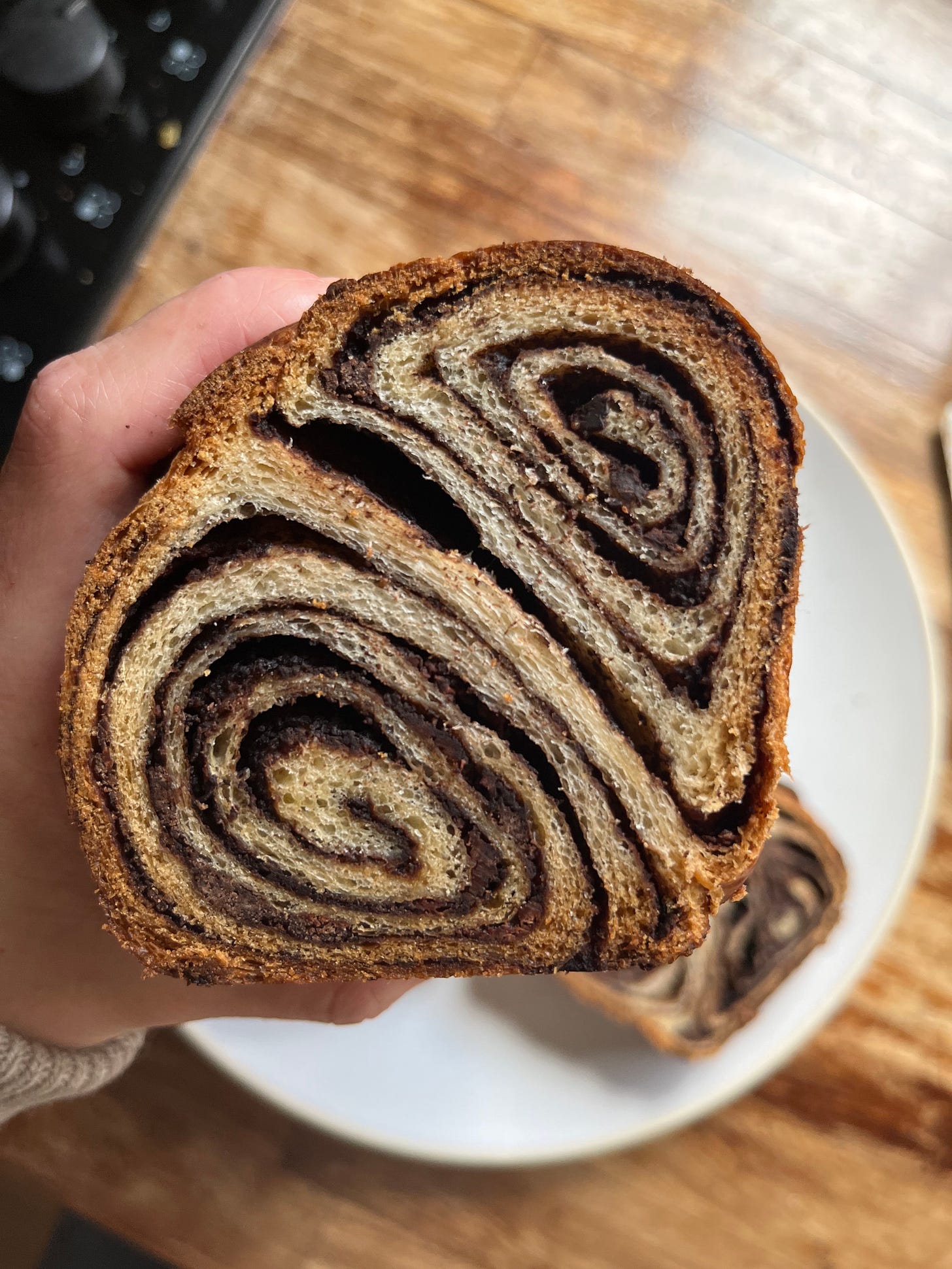
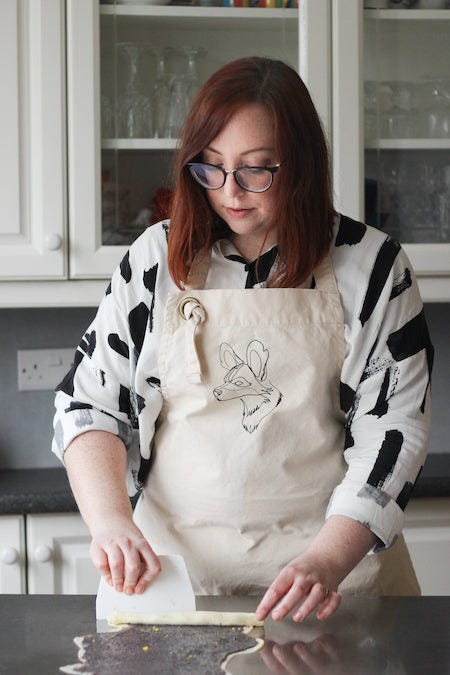
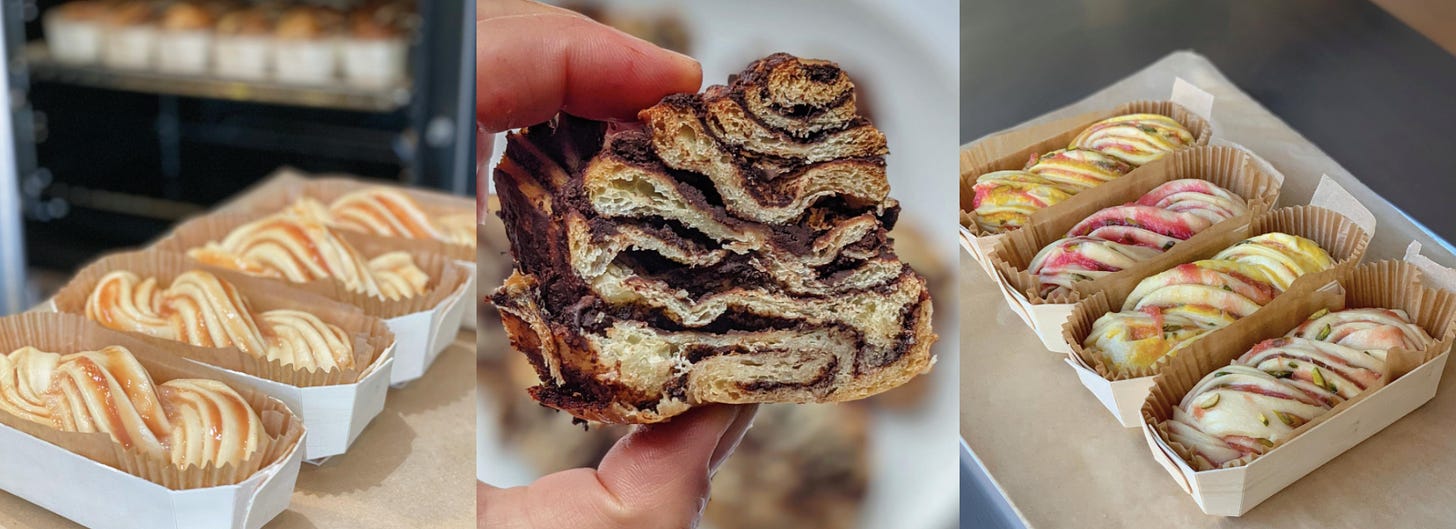
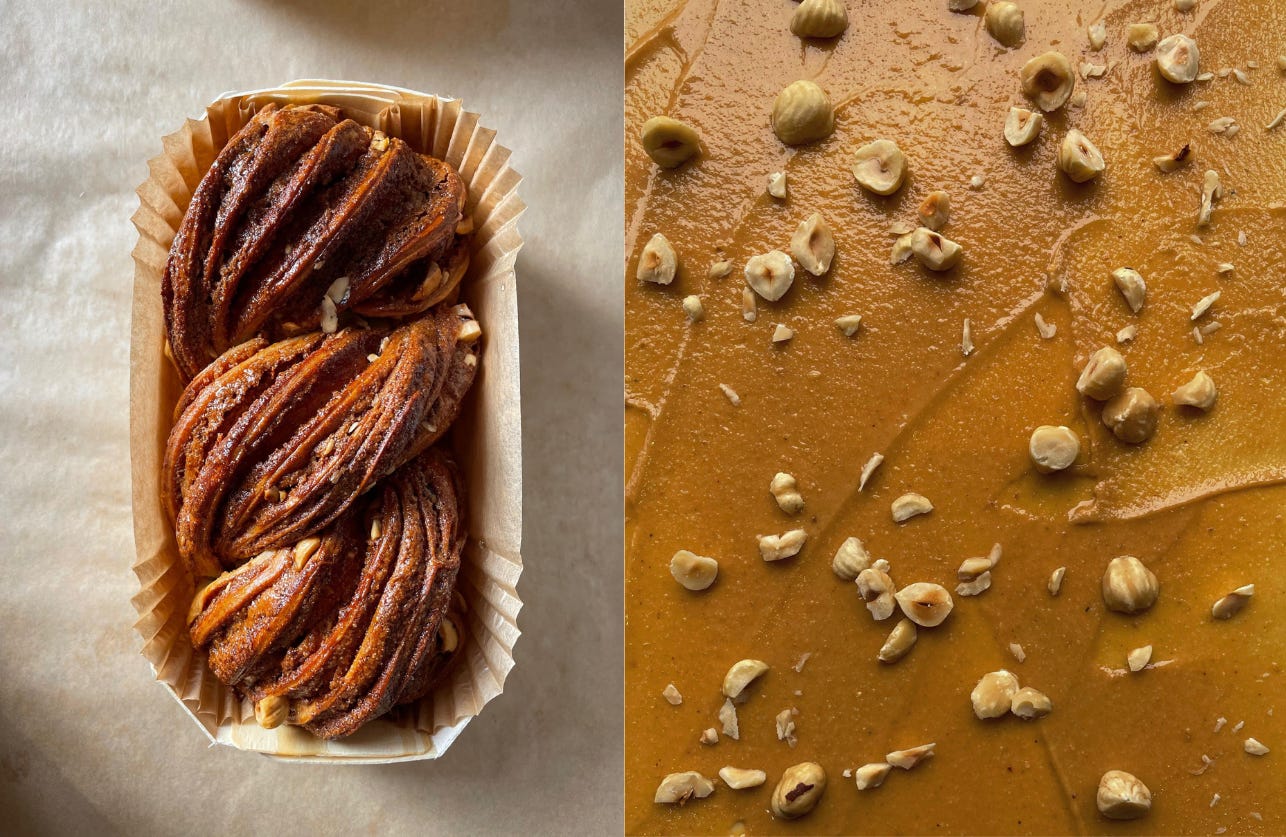


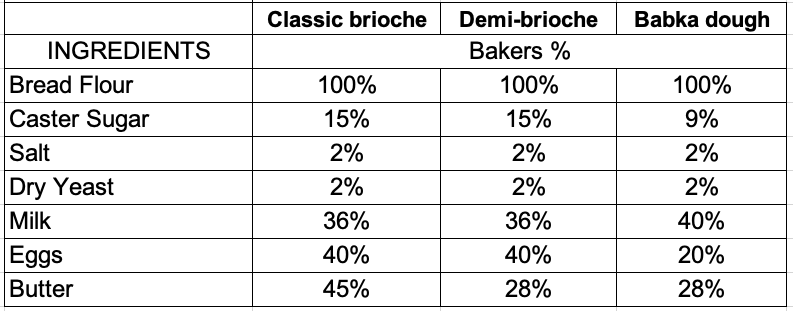
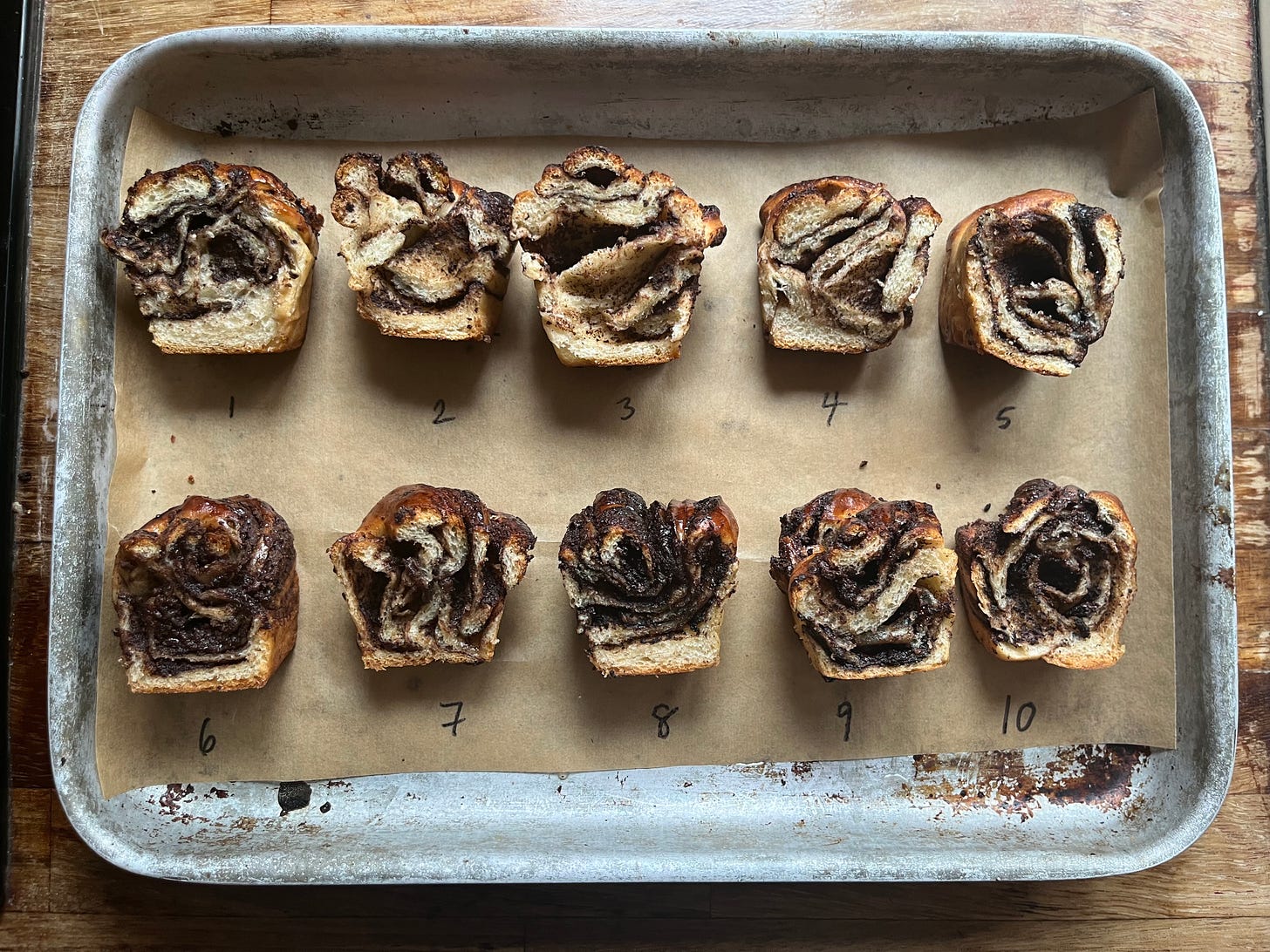

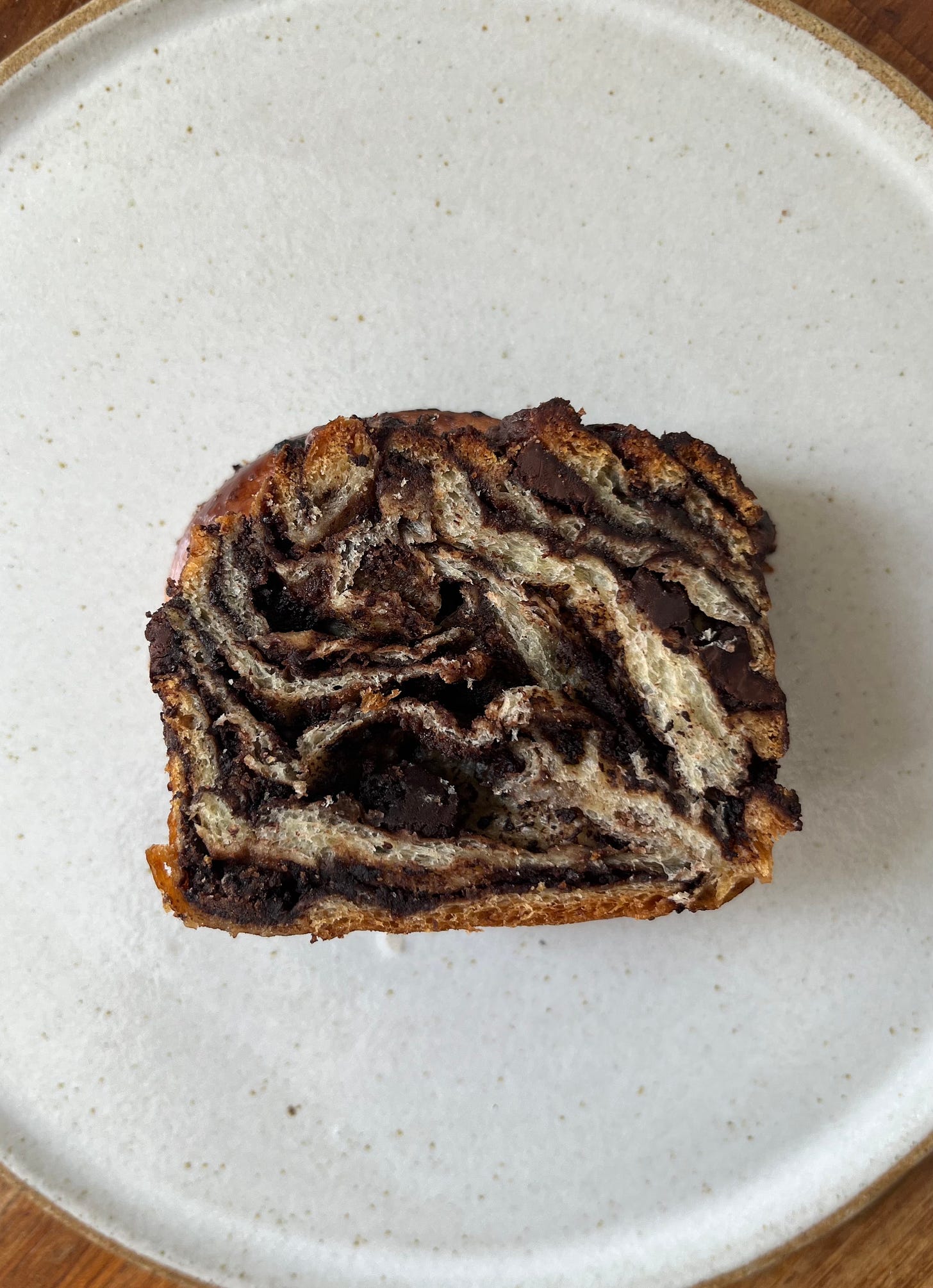

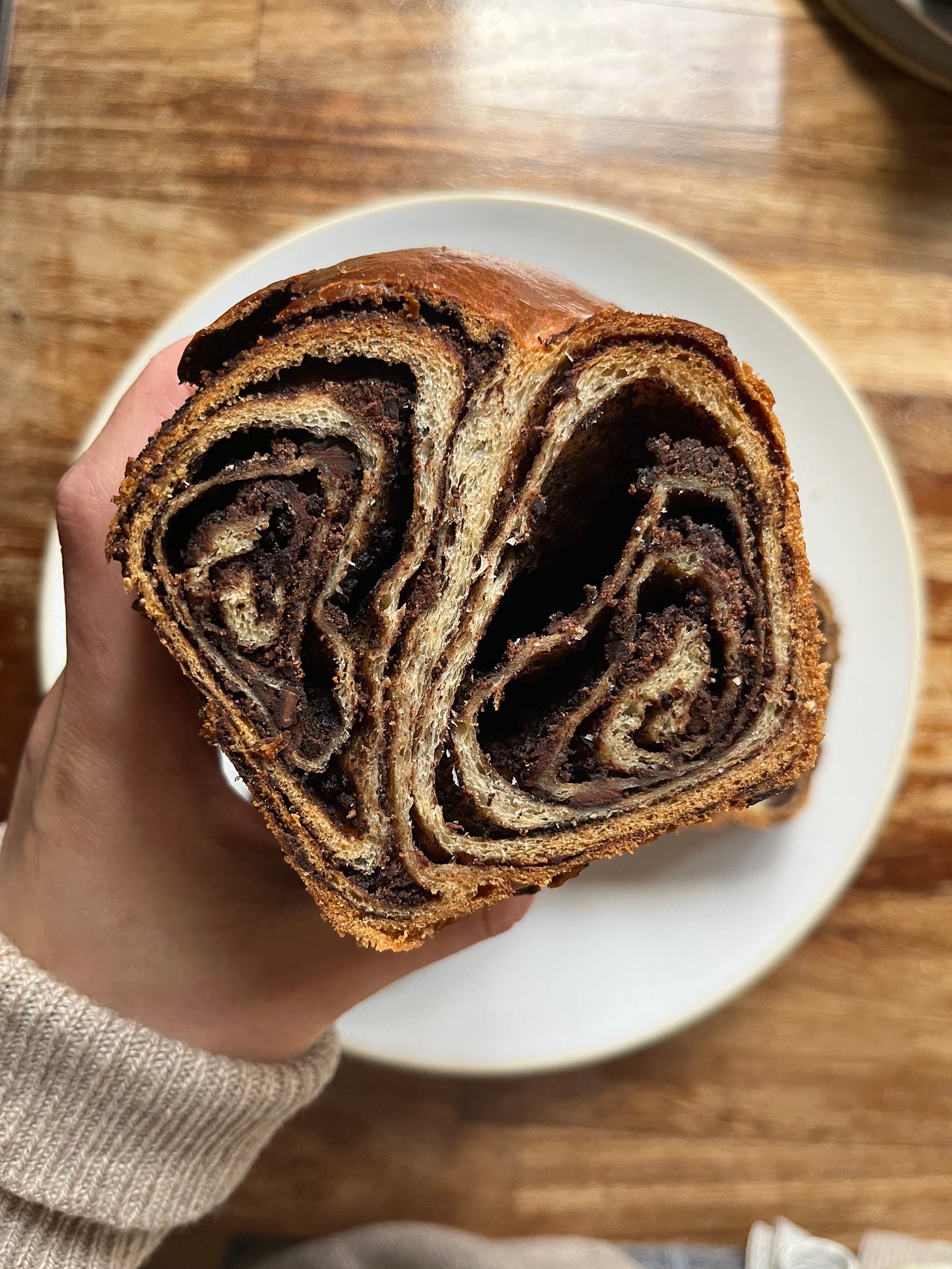
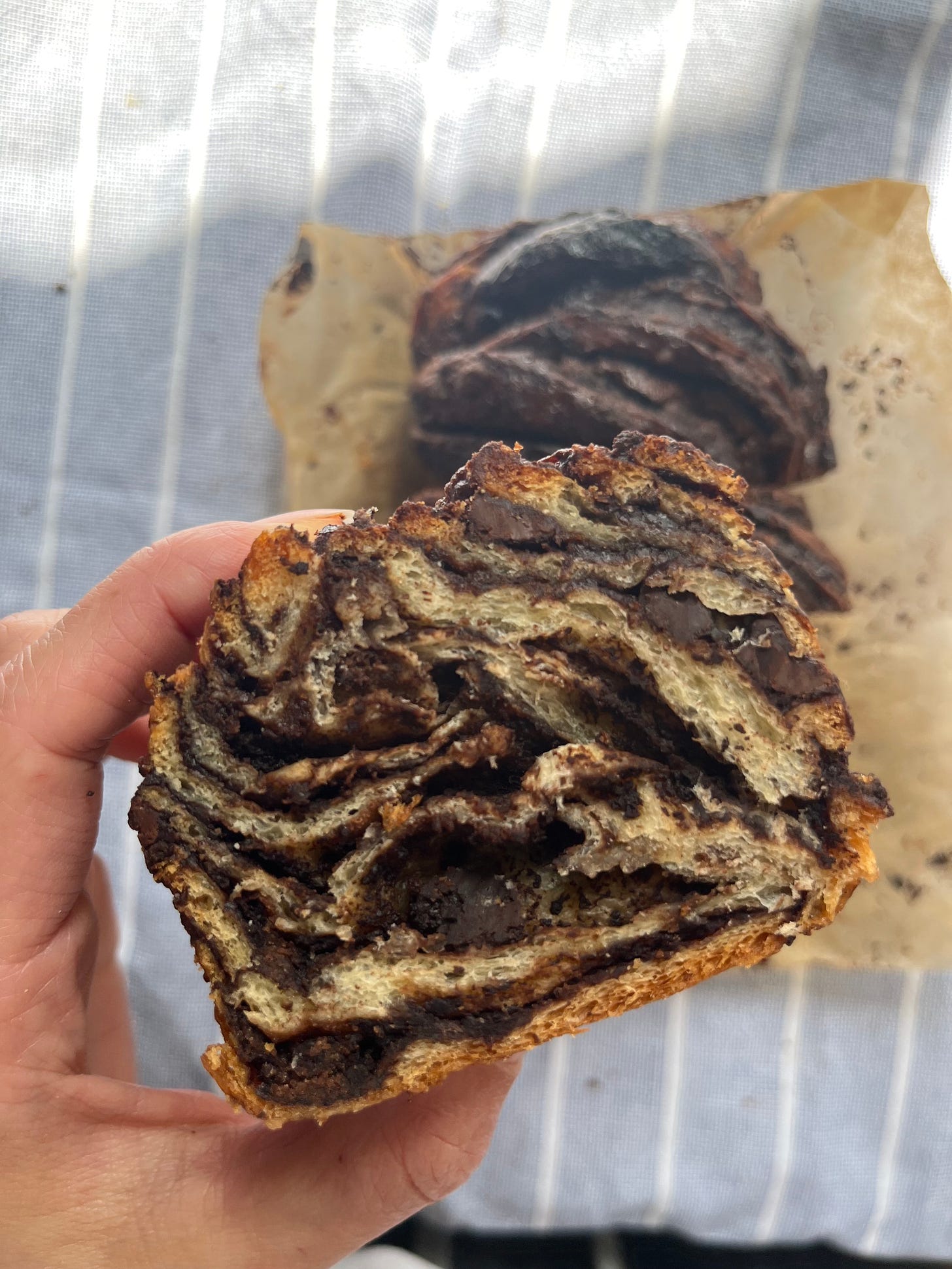

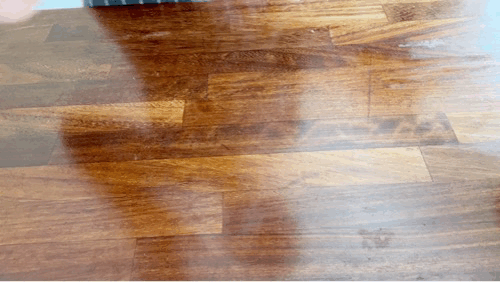
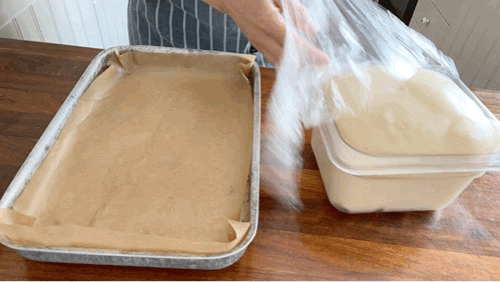

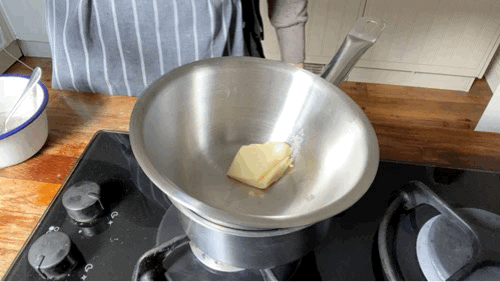

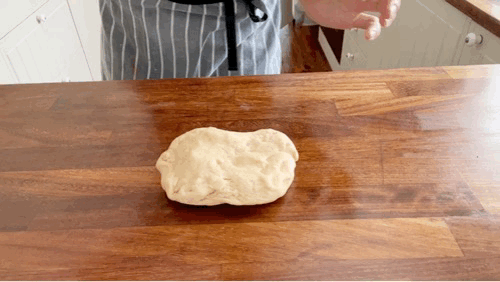
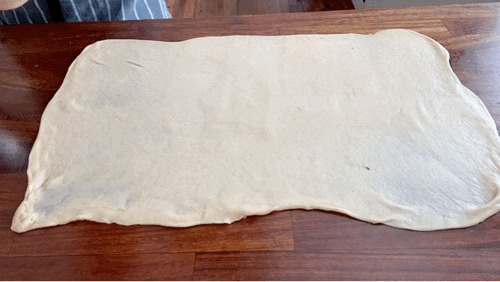
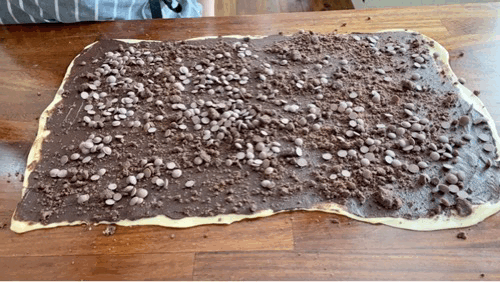


Quick question, please ... I watched the Russ & Daughters BTS video, and at the 3:30 mark of the video, can you identify the doughy mass that was included with the batch of eggs? It almost seems as if it was a strong levain or possibly a dough portion of one of their previous bread batches. Very curious and thank you.
Hi! I dont understand the active yeast thing. Should i use the common dry yeast and put it in first place with the dry ingredients??